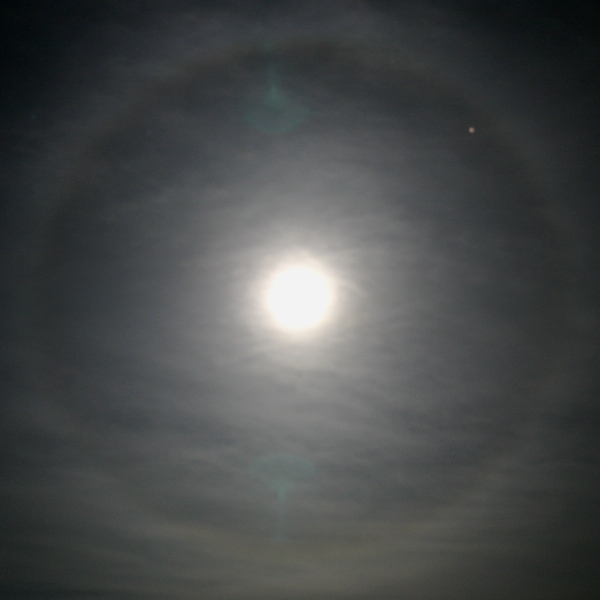
When the immediate environment is characterized with cold temperatures and wispy clouds, a moon around full will often
display the effect commonly referred to as a "lunar halo". Moisture within the wispy clouds will crystallize under
these cold temperatures and, when combined with lunar light, we have refractions within the hexagonal crystals which
lead to the effect depicted by the various phases of the moon. Furthermore, as is the case with
rainbows, the angle between the incident ray of lunar light
entering the ice crystal(s) and that redirected back to the observer (resultant ray) is known and, in the case of the
lunar halo, measures 22°; thus the size of the lunar halo depicted below is approximately 44° is diameter. Given the
large amount of sky these circles (or halos) cover, they are often missed when looking at the overhead moon.
Note: The reddish disk at the upper right quadrant and near the halo's border is Mars
just past its 2005 opposition lying at a distance of 95 million kilometers, shining at magnitude -1.2 and with an
apparent diameter of 14.80 arc-seconds.
|
Body: Moon Mass: 0.0123 x Earth Mean Eq Diameter: 0.2719 x Earth Distance: 386,036 km Sidereal Rev: 27d 07h 43m 11s Age: 12d 19h 55m Phase: 95.8° Diameter: 31.28' Magnitude: -12.1 Rukl: N/A |
 |
Date: December 13, 2005 18:40:55 - 18:41:05 UT+2 Location: Athens, Greece Equipment: Canon EOS 300d Canon EOS EF-S 18-55 mm @ 24 mm / f4.0 Exposure(s): 2 x 4.0 sec ISO 800 JPG FINE Image Format 3072x2048 Image Size Manual Mode Software: Canon FileViewer V1.3.2 Photoshop CS-II Processing: Layers and Lighten Resampling JPG Compression |